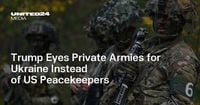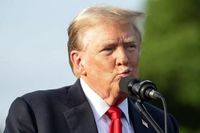In a dramatic turn of diplomatic strategy, U.S. President Donald Trump is reportedly negotiating a complex security arrangement for Ukraine that would rely on American private military contractors and a coalition of European allies, rather than traditional U.S. troops. The plan, which has been confirmed by multiple outlets including The Telegraph, The Mirror, and the Kyiv Independent, is emerging as a centerpiece of Trump’s effort to broker a peace deal with Russia while upholding his campaign promise to avoid sending American soldiers into Ukraine.
According to sources cited by The Telegraph on August 30 and 31, 2025, the proposed arrangement would see U.S. private military companies (PMCs) deployed to Ukraine after the signing of a peace agreement. These contractors would be tasked with building new defensive fortifications, restoring military infrastructure, and safeguarding American business interests in Ukraine—most notably those linked to a recent mineral extraction deal between Kyiv and Washington. The plan is designed to provide a deterrent to future Russian aggression, even as it sidesteps the politically sensitive issue of direct U.S. military involvement.
“This is a way for President Trump to keep his word to his supporters while still providing the kind of support Ukraine needs to protect itself,” a European official involved in the talks told The Mirror. The move is also being interpreted as a signal to Moscow that Western commitment to Ukraine’s security remains strong, even if the form of that commitment is evolving.
European allies have been closely involved in shaping the deal. France and the United Kingdom, in particular, are playing leading roles in developing a suite of security guarantees for Ukraine. As outlined by The Telegraph, these guarantees would likely include the deployment of European soldiers to a buffer zone near the Russian border and possibly stationing an additional 30,000 European troops deeper inside Ukraine. These forces, while not officially part of NATO, would provide a visible deterrent and help train Ukrainian soldiers in western regions of the country.
Turkey, too, is expected to join the coalition by providing naval security in the Black Sea—a move considered vital for safeguarding Ukraine’s critical exports of grain and sunflower oil. The Black Sea has long been a flashpoint in the conflict, with blockades and attacks threatening both Ukraine’s economy and global food supplies.
While the White House has maintained a firm line against sending U.S. troops, President Trump has expressed openness to providing air support to coalition-led peacekeeping forces if a settlement with Russia is reached. White House spokesperson Karoline Leavitt told reporters, “U.S. air support is an option and a possibility” within the context of security guarantees for Ukraine. This position reflects a nuanced approach: offering significant backing to allies and Ukrainian forces, but stopping short of a ground deployment that could escalate the conflict or draw the U.S. deeper into direct confrontation with Russia.
The discussions around these security guarantees gained momentum following the August 2025 U.S.–Russia summit in Alaska, where Trump met with Russian President Vladimir Putin to explore mechanisms for enforcing a potential ceasefire. According to The Telegraph, Trump’s willingness to consider air support and the deployment of private contractors may have been influenced by his discussions with Putin, who has historically rejected any presence of NATO troops in Ukraine as part of a peace deal. Russian officials have repeatedly stated their opposition to Western military deployments in Ukraine, making the use of PMCs a possible diplomatic workaround—though it remains to be seen whether Moscow will accept this arrangement.
The idea of deploying private military contractors is not without precedent. As The Mirror notes, similar tactics were used by the U.S. in Iraq and Afghanistan, where contractors built fortifications and supported military operations without the political baggage of official troop deployments. In Ukraine, these contractors would likely focus on constructing frontline defenses and new bases, as well as protecting American commercial interests tied to the country’s vast mineral resources.
Ukrainian President Volodymyr Zelenskyy has consistently argued that any peace deal must come with robust security guarantees to prevent future Russian incursions. On Ukraine’s Independence Day in August 2025, Zelenskyy delivered a defiant message: “We are building a Ukraine that will have enough strength and power to live in security and peace. What our future will be is up to us alone.” He also pledged that Ukraine “will never again in history be forced into the shame that Russians call compromise.”
Zelenskyy’s administration has outlined three key blocks for security guarantees: military support via domestic, European, and American production; NATO or “NATO-like” commitments from partners; and sanctions on Russia, including the use of frozen Russian assets for Ukraine’s reconstruction. The emerging plan led by Trump and his European counterparts appears to address the first two elements, though the exact details of sanctions and asset use remain under negotiation.
Notably, about ten countries are reportedly ready to send troops to Ukraine if a peace agreement is reached, following U.S. encouragement. This “coalition of the willing,” as described in The Mirror, would provide a multi-layered security presence, combining European military personnel, Turkish naval forces, and American contractors. The hope among European leaders is that even a limited American presence—albeit via private contractors—would serve as a powerful deterrent to Russian President Vladimir Putin.
Still, the plan faces significant hurdles. Russia’s public rejection of any foreign military presence in Ukraine, especially NATO-affiliated forces, casts doubt on the likelihood of Kremlin approval. Some analysts caution that the use of private contractors, while technically different from deploying troops, may be viewed by Moscow as a provocative move. The challenge for Trump and his allies will be to thread the needle: providing Ukraine with credible security while avoiding steps that could reignite large-scale hostilities.
In the meantime, Trump continues to press for a direct meeting between Putin and Zelenskyy, hoping that face-to-face negotiations might yield a breakthrough. The stakes are high, not just for Ukraine’s future but for the broader security architecture of Europe. As the details of the plan are hammered out, all eyes remain on Washington, Brussels, and Moscow to see whether this unconventional approach can deliver the “just peace” that Zelenskyy and his allies have been demanding.
The coming weeks will reveal whether this mix of private contractors, European soldiers, and diplomatic maneuvering can succeed where previous efforts have failed. For now, the world watches as Ukraine’s fate—and the balance of power in Eastern Europe—hangs in the balance.





